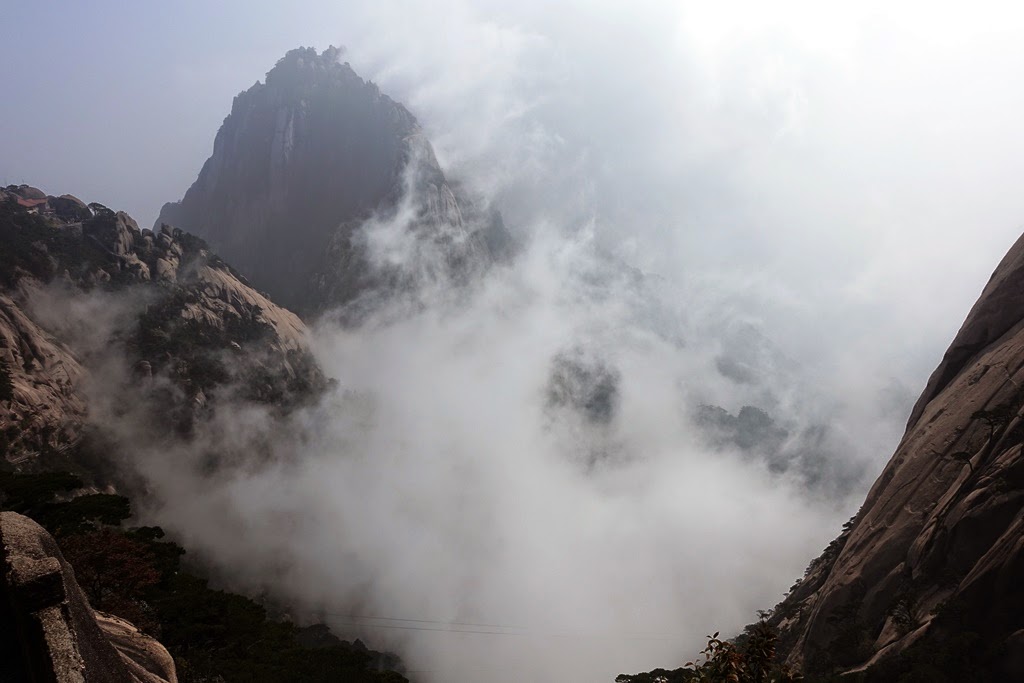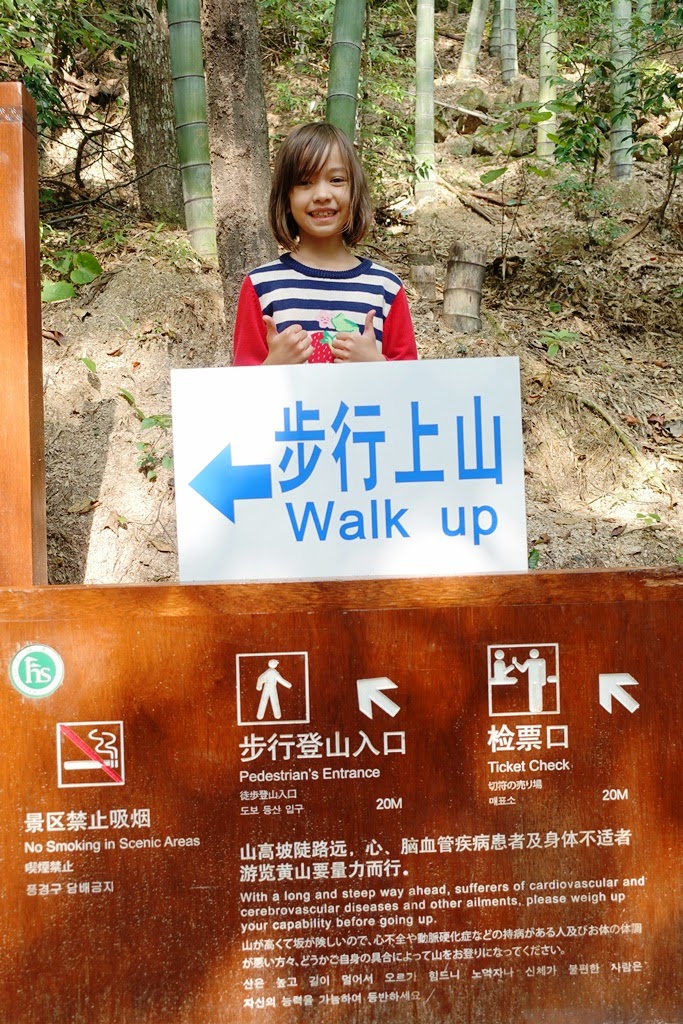Walking down a mountain is easier than walking up a mountain, right?
The fog was thick and heavy on Monday morning (Columbus Day) on the summit of Huángshān 黄山, one of the most famous mountains in China. The atmospheric conditions had already put paid to my wife's idea of waking up before dawn in order to see the sunrise (a blessing in disguise, allowing me to get some much-needed sleep), and we wondered if it would still be a good idea to go ahead with our plan of descending from the mountain via the long and laborious western route. The staff at the hotel where we'd spent the night were telling people that it would take 6-7 hours to walk down and that trail conditions were "dangerous". Pamela suggested we walk the first few kilometers to test things out for ourselves; if it was as bad as advertised, we could always descend via the cable car, which was operating despite the heavy fog. Suitably attired, we set out from the hotel and into the mist:
You have to go up before you can go down. My wife huffs and puffs her way upstairs through the fog:
The first landmark we reached was the Flying Rock 飞来石, looking suitably eerie in the morning mist:
Bright Summit Peak (1841 meters/6040 feet) was anything but. However, while the fog was thick, it wasn't raining and the ground didn't seem particularly slippery, so we decided to go ahead with our planned descent on foot. But not before stocking up on hard-boiled eggs first:
There wasn't much to see as we began making our way down, but everyone was in a good mood:
Finally, in an area known as Áoyú Peak (1780 meters/5840 feet), we broke through the cloud cover, and the magnificence of the scenery on Huangshan began to appear before us:
The staircase clung to the side of the mountain as it snaked its way downhill, with the wind whipping up at times. Looking back, we were amazed both at how far we'd come and where exactly we'd been walking:
Things were beginning to warm up as the sun started to break through the clouds:
Unlike the eastern route, which is under a forest canopy for the most part, the western steps are exposed, providing the views that have served as inspiration for generations of Chinese artists and poets:
If you look closely at the photograph below, you will see a steep stone staircase making its way up the granite peak. This is the famed Heavenly Capital Peak 天都峰 (1810 meters/5938 feet), the most celebrated stretch of trail on Huangshan, providing its most staggeringly beautiful views. However, with an eight year-old in tow and with no idea how long it was going to take us to reach the bottom, we skipped this detour:
Pine trees cling precariously to outcroppings everywhere on the mountain:
Eventually, the stone steps carved out of the side of the mountains turned into the Never Ending Staircase. Legs became wobbly as continued the descent, but Amber soldiered on, often leading the way:
For those whose knees and legs couldn't take the steps any longer, sedan chairs were available (at a hefty cost). Little did I realize...:
Pamela was starting to lag behind us. True to form, she stubbornly insisted we go on ahead and not wait up for her, which me did, admiring the views along the way:
Looking back up at the mountain. My wife was nowhere in sight:
Five hours and ten minutes after leaving our hotel, we reached the end of the western steps! I couldn't have been more prouder of my daughter - for 15 kilometers (9.3 miles), she made her way downhill unaided, and at the end was still as cheerful and energetic as ever, betraying no hint of fatigue or muscle ache. Ah, youth...:
The same could not be said for poor Pamela, however, who made her way down about 20 minutes later. It turned out that she'd ended up employing the services of the sedan chair bearers as her legs wouldn't let her go any further down those damned stone steps. I have a strong feeling that this will be the last time my wife will join me and Amber on a hike:
The western steps route ends at the photogenic Mercy Light Temple 慈光阁. From there, we caught a minibus back to Tāngkŏu 汤口, where we'd left our car while we ascended the mountain the day before:
From Tangkou we drove to the old trading town of Túnxī 屯溪. After checking into our hotel, we went out for dinner, where we celebrated (or in Pamela's case, tried to recover from) our successful descent from one of China's most beautiful mountains with a local beer:

































No comments:
Post a Comment